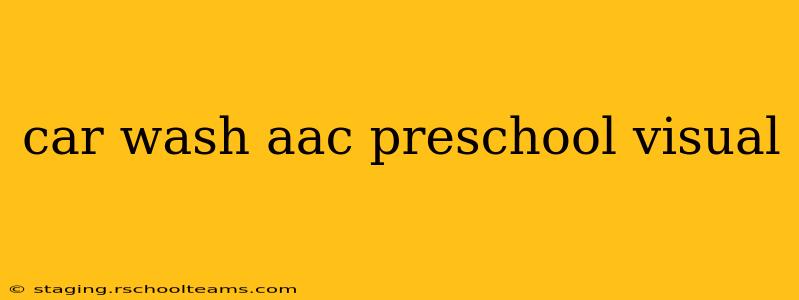Teaching young children, especially those who rely on Augmentative and Alternative Communication (AAC) systems, requires creative and engaging methods. This post explores how visual aids, specifically car wash themed visuals, can be effectively used in a preschool setting to enhance communication, vocabulary development, and overall learning for non-verbal children. We'll address common questions surrounding this approach and provide practical tips for implementation.
What are AAC Visuals and Why Use Them?
Augmentative and Alternative Communication (AAC) uses various methods to support individuals who have difficulty communicating verbally. Visual supports, such as pictures, symbols, and real objects, are a core component of AAC. They provide a bridge between a child's thoughts and the ability to express them. For preschoolers who are non-verbal or have limited verbal skills, visual aids are essential for:
- Communication: Providing a means to express needs, wants, and ideas.
- Vocabulary Development: Exposing children to new words and concepts through visual representation.
- Understanding: Clarifying instructions and routines, making learning more accessible.
- Engagement: Making learning fun and interactive through thematic activities.
A car wash theme offers a particularly engaging and relatable context for young children, easily capturing their attention and encouraging participation.
How Can I Use a Car Wash Theme for AAC Visuals?
The car wash theme offers a plethora of opportunities to create engaging and effective AAC visuals. Consider these possibilities:
Creating Car Wash Visuals:
- Picture Cards: Create or print cards depicting various aspects of a car wash: soapy water, sponge, rinse, dry, shining car, etc. Use clear, concise images and consider using a system like Boardmaker or other AAC software for symbol consistency.
- Real Objects: Gather real-life items like a small sponge, toy car, spray bottle, and towel to supplement the picture cards, making the learning experience more tactile.
- Sequencing Cards: Create a sequence of cards showing the steps involved in washing a car, allowing children to learn about cause-and-effect relationships and the order of events.
- Interactive Boards: Develop a visual communication board with pictures representing different actions or choices within the car wash context (e.g., "soap," "rinse," "dry").
Integrating the Visuals into Activities:
- Dramatic Play: Set up a pretend car wash area with toy cars and the visual aids. This allows children to practice communication through actions and choices.
- Storytelling: Create a story about a car wash adventure, incorporating the visual aids to help children follow along.
- Songs and Rhymes: Use songs and rhymes related to car washing, pointing to the corresponding visual aids as you sing.
- Games: Design simple games using the car wash visuals, such as matching games or sequencing activities.
What are Some Specific Car Wash Vocabulary Words to Target?
The car wash theme provides an opportunity to introduce various vocabulary words, depending on the child's developmental level. Some examples include:
- Action verbs: Wash, rinse, dry, scrub, spray, shine, clean.
- Descriptive words: Soapy, wet, shiny, clean, dirty, bubbly.
- Tools: Sponge, soap, bucket, hose, towel, dryer.
- Colors: Red, blue, green, yellow (to describe the cars).
How Can I Make My Car Wash Visuals More Engaging?
Consider these tips for creating engaging and effective car wash AAC visuals:
- Use High-Quality Images: Clear, colorful, and age-appropriate pictures are crucial for capturing attention.
- Keep it Simple: Avoid overwhelming the child with too many details or choices.
- Personalize it: Use pictures of the child's favorite car or characters.
- Make it Multi-Sensory: Incorporate tactile elements like textures and sounds.
- Regularly Review and Update: Adjust the visuals and vocabulary based on the child's progress and interests.
How Do I Integrate Car Wash AAC Visuals with Other Therapeutic Approaches?
Car wash visuals can be integrated seamlessly with other therapeutic approaches like play therapy, occupational therapy, and speech therapy. The collaborative use of visuals across different therapies can reinforce learning and promote consistent communication strategies. Consult with the child's therapists to develop a cohesive and comprehensive plan.
By implementing engaging car wash-themed AAC visuals, preschool educators can create a fun and supportive learning environment where non-verbal children can actively participate, communicate effectively, and develop crucial language and communication skills. Remember to adapt and adjust your approach based on the individual needs and preferences of each child.
